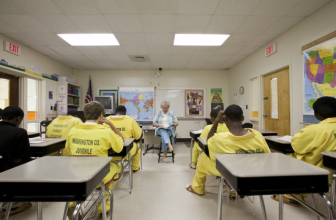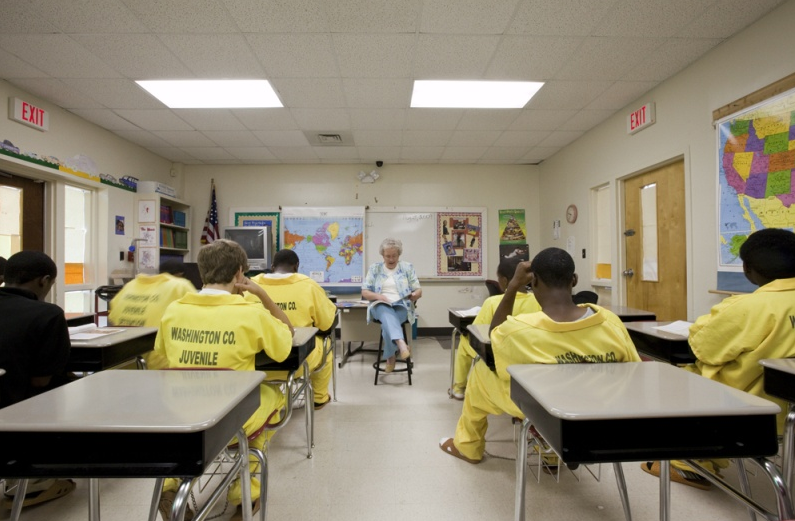
Photo by Richard Ross
When 17-year-old Moriah Barrett first entered Camp Scott, a juvenile detention facility in Los Angeles County, Calif., she was already far behind in school credits in completing the 11th grade. Because of her charges, she would be spending the next five months of her life at the all-girls’ facility — finishing high school wasn’t on her mind.
But at Camp Scott, Moriah enrolled at the Road to Success Academy, a public school run by the Los Angeles County Office of Education and housed within the juvenile detention facility. She said it wasn’t like anything she had expected.
Instead of filling in photocopied packets like she did at juvenile hall, she was working on science projects that involved rockets or writing beats about the human skeletal system. She wrote self-reflective essays, painted murals, and met weekly with a counselor to check in on her credit status. Within five months, she was able to complete her GED.
“When I was at Road to Success, it was completely different. They had devoted teachers,” Moriah said. “You can see they’re caring. They don't give up on you.”
The Road to Success Academy, which started in 2010 as a pilot project, is among a handful of schools across the nation that have been trying to turn the tide of poor education within juvenile justice facilities. Their models have included innovative ways of teaching, emphasis on higher education and the recruitment of high quality teachers.
A recent report released by the Southern Education Foundation highlighted the inadequacies and lack of emphasis on education in youth detention centers across the country. The report compiled federal data on measures that looked at how many eligible students completed their GED or finished credits during their time of incarceration.
In 2009, fewer than half the students of high school age who were enrolled for 90 or more days in juvenile justice schools across the country completed one or more credits, according to the federal Office of Juvenile Justice and Delinquency Prevention. Only 9 percent of students between the ages of 16 and 21 were shown to have earned a GED or a high school diploma.
However, the data were also problematic because many youth in the system weren’t being tested consistently enough to track their educational progress, said Katherine Dunn, program officer at the Southern Education Foundation.
“A lot of these youth are in facilities that make it clear that education is not a priority,” Dunn said.
Despite the findings, the report highlighted the Maya Angelou Academy in the New Beginnings Youth Development near Washington, D.C., as one successful model for teaching in locked facilities. The school, which is part of a network of charter schools, started in 2007 and has focused on individualized curriculum, smaller classes and shorter units to allow youth to accumulate credits quickly.
“You want to create an environment of achievement — get in and get some wins,” said David Domenici, co-founder and former principal of the Maya Angelou Academy.
He said that in the beginning, it was like “hand-to-hand combat” on changing the everyday culture of a facility — stopping officers from disrupting classroom time and taking students out of class, or convincing authorities that hanging students’ plaques on the walls wouldn’t be potential weapons.
But soon enough, the Academy began to see progress. By testing students at the time of incarceration and again after they completed their sentences, the school found that, on average, students made 1.3 to 1.4 years of improvement in nine months. Some who were released went on to college.
At the Road to Success Academy in Los Angeles County, the curriculum is based on themes that incorporate social and emotional elements into the teens’ education, such as power or hope.
The school has seen impressive gains in reading and math scores, said Diana Velasquez-Campos, director of the Road to Success Academies initiative. Students are tested every 60 days, and on average, scores go up half a grade level to one full grade level in both math and reading, she said.
“It’s been amazing,” Velasquez-Campos said. “We just didn’t expect the returns we get from out students – they’re just so incredibly bought into the content and learning.”
Domenici, who has since left Maya Angelou to head the Center for Educational Excellence in Alternative Settings, says that although good schools in juvenile detention facilities across the country vary, they have the same key principles: high-quality teachers and the ability to make the curriculum relevant to youth who are in the system.
Strong leadership has also played a role in these schools. For the Road to Success Academy, a lot of the support came from the superintendent and from a commitment by the school district, Velasquez-Campos said.
Domenici says that structural challenges are one of the main issues holding back juvenile justice schools from implementing quality education.
He says many schools within juvenile facilities are “off the accountability grid.” In some states, local school districts are in charge of education within facilities. Other times, it’s up to the facility itself to provide some sort of schooling.
In Indiana, statewide teacher evaluations are used for teachers in juvenile justice centers to support standards, something that’s not done in other states, Domenici said.
But in addition to structure, value is also an issue in improving education, he said.
“People view these kids as throwaway kids so they don’t prioritize education,” he said. “Schools in youth correctional settings are undervalued and underperform.”
Michelle Newell, senior policy associate at the Children’s Defense Fund, says students should be treated as students and learners rather than inmates.
“Educational success in a locked facility is directly connected and correlated to whether a young person can turn their life around,” she said.
Velasquez-Campos, director of the Road to Success Academies initiative, agrees that for education in these facilities to work, students must be at the center all decisions, whether it’s about the facility or curriculum.
In the fall, the Road to Success Academy will extend to three more detention centers in Los Angeles County, and to three more in 2015 – which means that more than half the juvenile detention centers in Los Angeles County will have Road to Success schools.
Moriah, who had originally intended to join the Marines before attending the school, left the Academy in November and is now getting ready to attend Citrus College, a community college in the suburbs of Los Angeles.
“[The Academy] made me want to go further because it was a different way or learning,” she said. “It helped me know I could go farther with my education.”
Financial supporters of The JJIE may be quoted or mentioned in our stories. They may also be the subjects of our stories.
